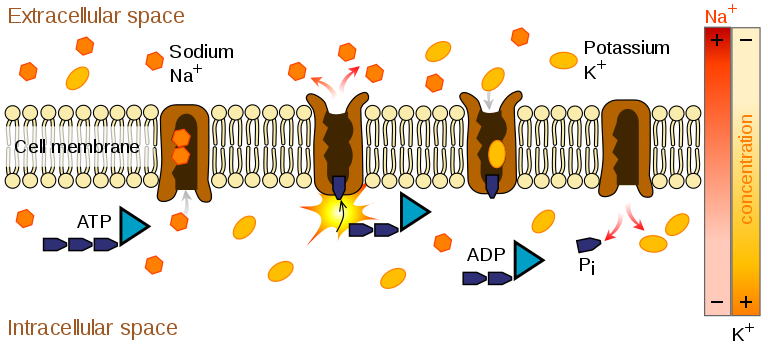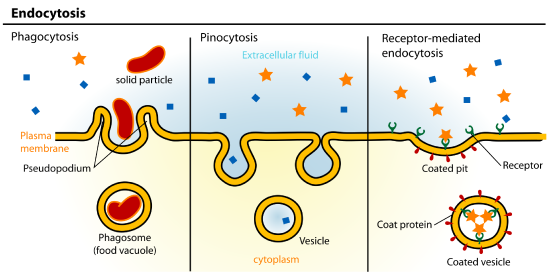3.8: Active Transport and Homeostasis
- Last updated
- Save as PDF
- Page ID
- 85207
Like Pushing a Humvee Uphill
You can tell by their faces that these airmen are expending a lot of energy trying to push this Humvee up a slope. The men are participating in a competition that tests their brute strength against that of other teams. The Humvee weighs about 13,000 pounds, so it takes every ounce of energy they can muster to move it uphill against the force of gravity. Transport of some substances across a plasma membrane is a little like pushing a Humvee uphill — it can't be done without adding energy.

What Is Active Transport?
Some substances can pass into or out of a cell across the plasma membrane without any energy required because they are moving from an area of higher concentration to an area of lower concentration. This type of transport is called passive transport as you learned in the last section. Other substances require energy to cross a plasma membrane often because they are moving from an area of lower concentration to an area of higher concentration. This type of transport is called active transport. The energy for active transport comes from the energy-carrying molecule called ATP (adenosine triphosphate). Active transport may also require transport proteins, such as carrier proteins, which are embedded in the plasma membrane. Two types of active transport are pump and vesicle transport.
Pump
Two pump mechanisms (primary and secondary active transports) exist for the transport of small-molecular weight material and macromolecules. The primary active transport moves ions across a membrane and creates a difference in charge across that membrane. The primary active transport system uses ATP to move a substance, such as an ion, into the cell, and often at the same time, a second substance is moved out of the cell. The sodium-potassium pump is a mechanism of active transport that moves sodium ions out of the cell and potassium ions into the cells — in all the trillions of cells in the body! Both ions are moved from areas of lower to higher concentration, so energy is needed for this "uphill" process. The energy is provided by ATP. The sodium-potassium pump also requires carrier proteins. Carrier proteins bind with specific ions or molecules, and in doing so, they change shape. As carrier proteins change shape, they carry the ions or molecules across the membrane. Figure \(\PageIndex{2}\) shows in greater detail how the sodium-potassium pump works and the specific roles played by carrier proteins in this process.

To appreciate the importance of the sodium-potassium pump, you need to know more about the roles of sodium and potassium in the body. Both are essential dietary minerals, meaning you have to obtain them in the foods you eat. Both sodium and potassium are also electrolytes, meaning that they dissociate into ions (charged particles) in solution, which allows them to conduct electricity. Normal body functions require a very narrow range of concentrations of sodium and potassium ions in body fluids, both inside and outside of cells.
- Sodium is the principal ion in the fluid outside of cells. Normal sodium concentrations are about 10 times higher outside than inside of cells.
- Potassium is the principal ion in the fluid inside of cells. Normal potassium concentrations are about 30 times higher inside than outside of cells.
These differences in concentration create an electrical gradient across the cell membrane, called the membrane potential. the secondary active transport describes the movement of material using the energy of the electrochemical gradient established by the primary active transport. Using the energy of the electrochemical gradient created by the primary active transport system, other substances such as amino acids and glucose can be brought into the cell through membrane channels. ATP itself is formed through secondary active transport using a hydrogen ion gradient in the mitochondrion. Tightly controlling the membrane potential is critical for vital body functions, including the transmission of nerve impulses and the contraction of muscles. A large percentage of the body's energy goes to maintaining this potential across the membranes of its trillions of cells with the sodium-potassium pump.
Vesicle Transport
Some molecules, such as proteins, are too large to pass through the plasma membrane, regardless of their concentration inside and outside the cell. Very large molecules cross the plasma membrane with a different sort of help, called vesicle transport. Vesicle transport requires energy, so it is also a form of active transport. There are two types of vesicle transport: endocytosis and exocytosis.
Endocytosis
Endocytosis is a type of vesicle transport that moves a substance into the cell. The plasma membrane completely engulfs the substance, a vesicle pinches off from the membrane, and the vesicle carries the substance into the cell. It is used by all cells of the body because most substances important to them are polar and consist of big molecules, and thus cannot pass through the hydrophobic plasma membrane. When an entire cell or other solid particle is engulfed, the process is called phagocytosis. When fluid is engulfed, the process is called pinocytosis. When the content is taken in specifically with the help of receptors on the plasma membrane, it is called receptor-mediated endocytosis.

A targeted variation of endocytosis employs binding proteins in the plasma membrane that are specific for certain substances. The particles bind to the proteins and the plasma membrane invaginates, bringing the substance and the proteins into the cell. If passage across the membrane of the target of receptor-mediated endocytosis is ineffective, it will not be removed from the tissue fluids or blood. Instead, it will stay in those fluids and increase in concentration. Some human diseases are caused by a failure of receptor-mediated endocytosis. For example, the form of cholesterol termed low-density lipoprotein or LDL (also referred to as “bad” cholesterol) is removed from the blood by receptor-mediated endocytosis. In the human genetic disease familial hypercholesterolemia, the LDL receptors are defective or missing entirely. People with this condition have life-threatening levels of cholesterol in their blood because their cells cannot clear the chemical from their blood.
Exocytosis
Exocytosis is a type of vesicle transport that moves a substance out of the cell. A vesicle containing the substance moves through the cytoplasm to the cell membrane. Then, the vesicle membrane fuses with the cell membrane, and the substance is released outside the cell.

Homeostasis and Cell Function
For a cell to function normally, a stable state must be maintained inside the cell. For example, the concentration of salts, nutrients, and other substances must be kept within a certain range. The process of maintaining stable conditions inside a cell (or an entire organism) is homeostasis. Homeostasis requires constant adjustments because conditions are always changing both inside and outside the cell. The processes described in this and previous lessons play important roles in homeostasis. By moving substances into and out of cells, they keep conditions within normal ranges inside the cells and the organism as a whole.
Feature:Feature: My Human Body
Maintaining the proper balance of sodium and potassium in body fluids by active transport is necessary for life itself, so it's no surprise that getting the right balance of sodium and potassium in the diet is important for good health. Imbalances may increase the risk of high blood pressure, heart disease, diabetes, and other disorders.
If you are like the majority of Americans, sodium and potassium are out of balance in your diet. You are likely to consume too much sodium and too little potassium. Follow these guidelines to help ensure that these minerals are in balance in the foods you eat:
- Total sodium intake should be less than 2300 mg/day. Most salt in the diet is found in processed foods or added with a salt shaker. Stop adding salt and start checking food labels for sodium content. Foods considered low in sodium have less than 140 mg/serving (or 5% daily value).
- Total potassium intake should be 4700 mg/day. It's easy to add potassium to the diet by choosing the right foods, and there are plenty of choices. Most fruits and vegetables are high in potassium, but especially potatoes, bananas, oranges, apricots, plums, leafy greens, tomatoes, lima beans, and avocado. Other foods with substantial amounts of potassium are fish, meat, poultry, and whole grains.
Review
- Define active transport.
- What is the sodium-potassium pump? Why is it so important?
- Name two types of vesicle transport. Which type moves substances out of the cell?
- What are the similarities and differences between phagocytosis and pinocytosis?
- The sodium-potassium pump is a:
- Phospholipid
- Protein
- Carbohydrate
- Ion
- What is the functional significance of the shape change of the carrier protein in the sodium-potassium pump after the sodium ions bind?
- A potentially deadly poison derived from plants called ouabain blocks the sodium-potassium pump and prevents it from working. What do you think this does to the sodium and potassium balance in cells? Explain your answer.
- True or False. The sodium-potassium pump uses one protein to pump both sodium and potassium.
- True or False. Vesicles are made of the nuclear membrane.
- What is an electrical gradient across the cell membrane called?
- Chemical signaling molecules called neurotransmitters are released from nerve cells (neurons) through vesicles. This is an example of:
- Pinocytosis
- Phagocytosis
- Endocytosis
- Exocytosis
- The energy for active transport comes from
- ATP
- RNA
- Carrier proteins
- Sodium ions
- Transport proteins that move substances into and out of a cell are located in which structure?
Explore More
Attributions
- Competition by Airman 1st Class Collin Schmidt, public domain via Wikimedia Commons
- Sodium-potassium pump by LadyofHats Mariana Ruiz Villarreal, released into the public domain via Wikimedia Commons
- Endocytosis types by LadyofHats Mariana Ruiz Villarreal, released into the public domain via Wikimedia Commons
- Exocytosis by OpenStax, licensed CC BY 4.0 via Wikimedia Commons
- Text adapted from Human Biology by CK-12 licensed CC BY-NC 3.0
- Some text is adapted from Concepts of Biology by Open Stax, licensed CC BY 3.0


